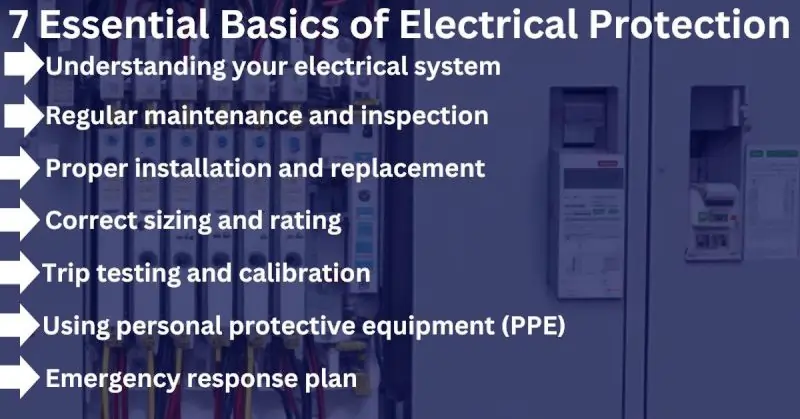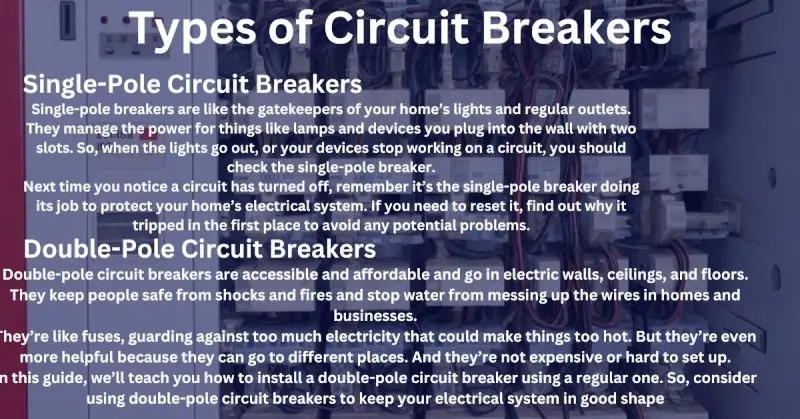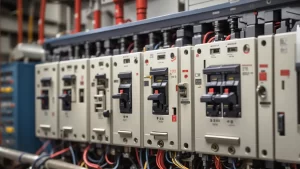Table of Contents
What Is The Function of Circuit Breaker
A circuit breaker is like a switch that keeps electrical systems safe. It has two parts: one that doesn’t move and one that does. Usually, they’re stuck together and let electricity flow. But they separate using stored energy when something goes wrong, like too much electricity or a short circuit. This separation makes a spark called an arc, which can be damaging if not stopped fast. Circuit breakers have ways to prevent this spark, like cooling it down or replacing the air around it. The choice depends on how strong the electricity is.
Circuit breakers protect electrical systems from damage caused by too much electricity or short circuits. They stop the flow of electricity when there’s a problem and turn it back on when it’s fixed. Unlike a fuse, which needs to be replaced after use, a circuit breaker can be used many times.
But even though it shuts off quickly, engineers must still design electrical systems that can handle the most substantial electric current during a problem.
7 Essential Basics of Electrical Protection



The seven essential basics of electrical protection are as follows:
- Understanding your electrical system – Know the components and how they work together.
- Regular maintenance and inspection – Keep electrical systems well-maintained and inspect them regularly.
- Proper installation and replacement – Ensure that electrical systems are installed and replaced correctly.
- Correct sizing and rating – Use circuit breakers that are appropriately sized and rated for the electrical load.
- Trip testing and calibration – Test circuit breakers regularly to ensure they trip at the correct current.
- Using personal protective equipment (PPE) – Wear PPE, such as gloves and safety glasses, when working on electrical systems.
- Emergency response plan – Have a plan for responding to electrical emergencies, including knowing how to shut off power in case of an emergency.
Classification of Circut Breakers



Oil Circuit Breaker
An oil circuit breaker (OCB) is a type of circuit breaker that uses oil as an insulating medium and an arc quenching medium. The oil is used to insulate the contacts of the circuit breaker and also helps extinguish the arc formed when the circuit breaker opens.
In an oil circuit breaker, the contacts are immersed in oil, which helps to cool and quench the arc generated when the circuit breaker opens. The oil also provides insulation between the contacts when the circuit breaker is closed.
Oil circuit breakers are like guardians for extensive electrical systems with lots of power. They’ve been doing this job for a long time and are good at it. But now, newer and greener options like vacuum and SF6 circuit breakers exist. These new ones are better for the environment and don’t need as much attention to stay in good shape.
Bulk Oil Circuit Breaker
A bulk oil circuit breaker (BOCB) is a type of oil circuit breaker that uses a large volume of oil as both an insulating and arc quenching medium. The oil is contained in a large tank, and the circuit breaker contacts are immersed.
When the circuit breaker is closed, the contacts are sealed in the oil, providing insulation and cooling. When the circuit breaker opens, the generated arc is quickly extinguished by the oil, which absorbs the heat and ionizes the gases, creating a channel for the arc to be extinguished.
Bulk oil circuit breakers were widely used in high-voltage power systems because of their high reliability and performance.
But now, there are better options for replacing them. Newer things like vacuum and SF6 circuit breakers are taking their place. These new ones are kinder to the environment and don’t need as much looking after.
Despite their decreasing popularity, bulk oil circuit breakers are still used in some industrial and utility applications, where their high interrupting capacity and reliability make them a preferred option.
Minimum Oil Circuit Breaker
A minimum oil circuit breaker (MOCB) is a type of oil circuit breaker that uses a small amount of oil as both an insulating and arc quenching medium. Unlike bulk oil circuit breakers, which use a large oil volume, MOCBs use less oil for arc extinction.
In an MOCB, the contacts are sealed in a chamber that contains a small amount of oil. When the circuit breaker is closed, the contacts are separated by a small gap, and the oil acts as an insulating medium between them. When the circuit breaker opens, an arc is generated, and the oil is used to extinguish the arc quickly.
MOCBs are often used in medium-voltage power systems. They are good at keeping things safe from electrical problems and work well. They are less expensive and require less maintenance than bulk oil circuit breakers but have a lower interrupting capacity.
MOCBs are gradually being replaced by newer technologies, such as vacuum and SF6 circuit breakers, which are more environmentally friendly and offer higher interrupting capacities.
Types of Circuit Breakers



Circuit breakers have different types. Some keep homes secure, while others safeguard fragile technology.
They stop electricity if there’s trouble and also manage its flow. Safety ones keep homes safe from fires and shocks, while load breakers shield gadgets from too much electricity. Some protect against power surges. Pick the right type for your needs.
Single-Pole Circuit Breakers
Single-pole breakers are like the gatekeepers of your home’s lights and regular outlets. They manage the power for things like lamps and devices you plug into the wall with two slots. So, when the lights go out, or your devices stop working on a circuit, you should check the single-pole breaker.
Next time you notice a circuit has turned off, remember it’s the single-pole breaker doing its job to protect your home’s electrical system. If you need to reset it, find out why it tripped in the first place to avoid any potential problems.
Single-pole circuit breakers are the most common type of circuit breaker used in North America. This type of circuit breaker is one of the most common types because it is straightforward to use and is typically inexpensive. Many electrical systems, including those in homes and businesses, employ this circuit breaker.
They’re designed to monitor the current of a single wire and trip in the event of an electrical overload.
Double-Pole Circuit Breakers
Double-pole circuit breakers are accessible and affordable and go in electric walls, ceilings, and floors. They keep people safe from shocks and fires and stop water from messing up the wires in homes and businesses.
They’re like fuses, guarding against too much electricity that could make things too hot. But they’re even more helpful because they can go to different places. And they’re not expensive or hard to set up.
In this guide, we’ll teach you how to install a double-pole circuit breaker using a regular one. So, consider using double-pole circuit breakers to keep your electrical system in good shape.
Top Circuit Breaker Reviews and Recommendations
Square D HOM115PCAFIC Circuit Breaker
Features & Specifications:
- Amperage: 15-Amp
- Voltage: 120V
- Pole: 1-Pole
- Technology: Combination Arc Fault Circuit Interrupter (CAFCI)
- Design: Plug-On Neutral
- Compatibility: Square D Homeline electrical panels
- Safety: Protects against both parallel and series arc faults
- Ease of Installation: Plug-on design for easy installation, eliminating the need for pigtail connections
- Durability: Constructed with high-quality materials for long-lasting performance
- Certifications: UL Listed for safety and compliance with industry standards
- Application: Suitable for residential use to protect circuits in bedrooms, living rooms, and other areas susceptible to arc faults
The Square D HOM115PCAFIC Homeline Circuit Breaker is a reliable and essential component for your electrical system. Designed to provide superior protection for your home’s circuits, this 15-Amp, 120V, 1-Pole circuit breaker features Combination Arc Fault Circuit Interrupter (CAFCI) technology and a convenient Plug-On Neutral design. It is a trusted choice for safeguarding your electrical circuits and preventing potentially hazardous arc faults
Pros:
- Enhanced Safety: The CAFCI technology detects and mitigates potentially dangerous arc faults, reducing the risk of electrical fires.
- Easy Installation: The plug-on design simplifies installation, making it accessible for DIY enthusiasts and professional electricians.
- Compatibility: Specifically designed for Square D Homeline panels, ensuring a seamless fit and optimal performance.
- Certified Safety: UL listing guarantees that this circuit breaker meets stringent safety standards.
- Versatile Use: Ideal for protecting circuits in bedrooms and living areas, where arc faults are most common.
Cons:
- Price: CAFCI circuit breakers tend to be more expensive than standard ones, which can be a drawback for budget-conscious consumers.
- Specific Compatibility: Limited compatibility with Square D Homeline panels may require additional consideration for homeowners with different panel brands.
